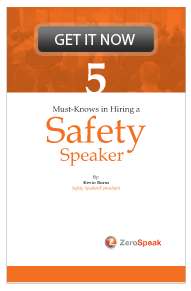7 Strategies To Become A More Effective Safety Leader
Safety management is a paid position. Safety leadership is voluntary - yet infinitely more rewarding.
 It’s time to take stock of where you are in your safety career and to find ways to tweak, adjust and fine-tune your performance. There is, in this post, already an assumption that you’re up to date on legislation, rules and procedures. If you’re missing that part, you can add those items to this list. But I don’t want to discuss your knowledge of safety. I want to help make you a better safety leader.
It’s time to take stock of where you are in your safety career and to find ways to tweak, adjust and fine-tune your performance. There is, in this post, already an assumption that you’re up to date on legislation, rules and procedures. If you’re missing that part, you can add those items to this list. But I don’t want to discuss your knowledge of safety. I want to help make you a better safety leader.
Safety leadership is NOT safety management. Let’s be clear about that. Safety management is a paid position. Safety leadership is voluntary - yet infinitely more rewarding. Also, you do not have to hold a safety position (or title) to be a safety leader. Safety leaders can be front-line personnel - especially supervisors.
Here are the seven personal strategies that are designed to help you become a more effective safety leader:
1Read. Read whatever it is that can improve you. Ordinary people become leaders over time. They read, they learn, they digest. The truth is, people don’t just change their minds. They make new decisions based on new information. So get some new information. Read. Walk into the book store and stand in front of the business, management and/or leadership section. Then scan the books on the shelves waiting for one to call your name. If there’s title that catches your eye, buy it. Then read it. Devour it. Learn from it. Then repeat.
2Ignore the trolls and critics. There are a lot of armchair critics telling you that what you believe about safety is wrong. There are trolls on the social safety networks who suck up the oxygen. Trolls and critics tear others down in the hopes that they might elevate themselves. Don’t give these energy vampires and attention-suckers a voice by engaging them. Focus your attention on being more effective with the people right in front of you who matter. Get into your zone where you engage and focus on what you believe is right. Tune out those who tell you that you’re wrong. Trust yourself that you are doing the right thing.
3Give yourself a mission. A mission is not a list of job duties. Your mission is the reason you get out of bed in the morning to do your job duties. It's the “why” of choosing to be a positive safety person. Why do you choose to be in safety? Why do you want to inspire others to safety? Why is it important to you? Write down why being a safety leader is important to you. Then finish this sentence: “my mission in safety is …” Then, go to the office supply store and have it laminated on a business-card. Carry it with you everywhere. Pull it out of your wallet several times per week and read it. Remind yourself of your safety mission. Stay focused.
4Activate courtesy. The first three strategies are internal things you can do. Now, let’s move outside of yourself. Be courteous - in your actions, your words and your planning. There isn’t a strong safety program that doesn’t have both courtesy and respect at its foundation. Courtesy is one’s willingness to act outside of themselves for the benefit of others. It's called service. Courtesy fosters respect. It’s impossible to exercise courtesy and to be selfish at the same time. A willingness to look out for someone else’s safety begins with courtesy and respect. Do courteous things. Over time, they become natural.
5Engage in purposeful communication. What is it that your co-workers need to know that will help them be better at their jobs and safer? How will you communicate what they need to hear in a way that they want to hear it, and then comprehend it? You say the word “dog” and everyone sees a dog in their mind. But it’s not the same dog, same breed, same color, same anything. Say the word “safety” and everyone sees something but no two people see the same thing. So be purposeful in your communication. Get specific. Give people the tools to be exceptional at safety. Ensure they understand.
6Mentor others. The Roman philosopher Seneca said, “while we teach, we learn.” Science has proven that students who tutor others learn the material better and score higher on exams. Older siblings also tend to be more intelligent from helping younger siblings learn the ropes. To become an exceptional safety leader, mentor others to become exceptional safety leaders. It forces you to up your game. If you’re in a safety management position, start mentoring your eventual replacement now. Groom them to a seamless transition for the company. You will build a solid team of safety performers. That is a comforting feeling.
7Be bigger. Stretch yourself. Push your boundaries. Do not be satisfied with your performance. Always be improving. Raise the bar for yourself - then, and only then, can you raise the bar for your team. Show up bigger. Get addicted to improvement and success. Surpass the industry-average safety performance. Go as far beyond averages as possible. Look for ways to become the Top 1% in your industry. Become the leader in all categories. Become the go-to person, the example of how others should do it. Show up bigger - and stay there.
Once again, you don't have to be in management to be a safety leader.
 Kevin Burns is a management consultant, safety speaker and author of "The Perfect Safety Meeting" and his newest #1 Amazon Health & Safety Bestseller, "Running With Scissors - 10 Reasons To Invest in Safety In Slow Times." He is an expert in how to get through to people - how to talk with them so they hear and understand. Kevin's presentation "Trust The Process - Instill A Safety Attitude To Build An Engaged Culture Of Safety" will help your organization reach the following goals: better engagement and buy-in to safety, increased teamwork, better communication, lower turnover resulting in increased profits from production. Click below for more information and to discuss your needs with Kevin.
Kevin Burns is a management consultant, safety speaker and author of "The Perfect Safety Meeting" and his newest #1 Amazon Health & Safety Bestseller, "Running With Scissors - 10 Reasons To Invest in Safety In Slow Times." He is an expert in how to get through to people - how to talk with them so they hear and understand. Kevin's presentation "Trust The Process - Instill A Safety Attitude To Build An Engaged Culture Of Safety" will help your organization reach the following goals: better engagement and buy-in to safety, increased teamwork, better communication, lower turnover resulting in increased profits from production. Click below for more information and to discuss your needs with Kevin.



